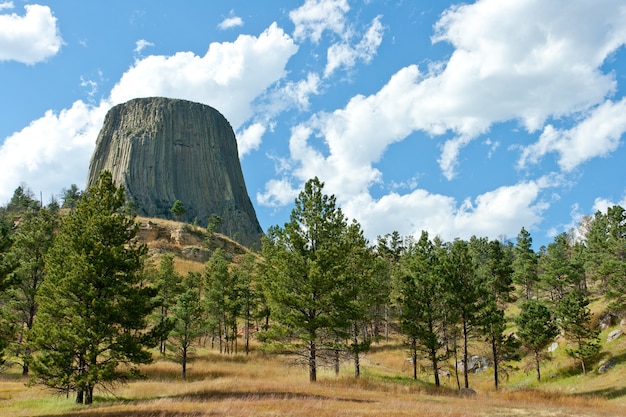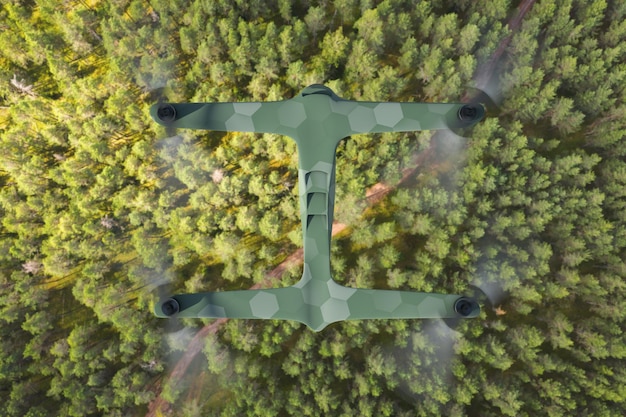AI in Environmental Conservation: Protecting US Ecosystems

AI in environmental conservation is revolutionizing how we monitor and protect US ecosystems by providing advanced tools for data analysis, predictive modeling, and automated monitoring.
The application of AI in environmental conservation is rapidly transforming the way we understand, monitor, and protect the diverse ecosystems across the United States. From predicting wildfires to tracking endangered species, AI offers invaluable tools for conservation efforts.
The Rise of AI in Environmental Monitoring
Artificial intelligence has emerged as a powerful tool in various sectors, and its application in environmental monitoring is particularly promising. By leveraging machine learning algorithms and data analytics, AI can process vast amounts of environmental data more efficiently and accurately than traditional methods.
This technological advancement allows conservationists to gain deeper insights into ecosystem dynamics, predict potential threats, and implement targeted conservation strategies. The integration of AI is not just about improving efficiency; it’s about gaining a more comprehensive understanding of the interconnectedness of our natural world.
Enhancing Data Collection with AI
AI-powered technologies are revolutionizing data collection in environmental monitoring. Here’s how:
- Remote Sensing: AI algorithms analyze satellite imagery and aerial imagery to monitor deforestation, track changes in land use, and assess the health of vegetation.
- Sensor Networks: AI integrates data from a network of environmental sensors, providing real-time information on air and water quality, temperature, and other critical parameters.
- Acoustic Monitoring: AI algorithms analyze audio recordings to identify and track animal populations, detect illegal logging activities, and monitor the health of ecosystems.
Predictive Modeling for Conservation
One of the most significant contributions of AI is its ability to create predictive models that forecast environmental changes and potential threats. These models help conservationists anticipate and mitigate risks before they escalate.
For example, AI can predict the spread of invasive species based on environmental factors and historical data. This allows conservationists to implement targeted removal programs and prevent further ecological damage.
In conclusion, the rise of AI in environmental monitoring represents a paradigm shift in conservation efforts. By enhancing data collection and enabling predictive modeling, AI empowers conservationists to make more informed decisions and protect our planet’s precious ecosystems.
AI-Driven Wildlife Conservation Efforts
Wildlife conservation is one area where AI is making a significant impact. Traditional methods of tracking and monitoring wildlife populations are often time-consuming and resource-intensive. AI offers more efficient and accurate solutions for these challenges.
By using AI-powered technologies, conservationists can gain better insights into animal behavior, movement patterns, and population dynamics. This information is crucial for developing effective conservation strategies and protecting endangered species.

Tracking Endangered Species
AI plays a vital role in tracking endangered species. Technologies like:
- Camera Traps: AI algorithms analyze images from camera traps to identify and count individual animals, providing valuable data on population size and distribution.
- GPS Tracking: AI integrates data from GPS collars to monitor animal movement patterns, identify critical habitats, and assess the impact of human activities.
- Facial Recognition: AI is being used to develop facial recognition software for animals, allowing researchers to identify individuals and track their movements over time.
Combating Poaching with AI
Poaching is a major threat to wildlife populations around the world. AI can help combat poaching by:
- Predictive Analytics: AI algorithms analyze poaching patterns and environmental factors to predict poaching hotspots, allowing law enforcement to deploy resources more effectively.
- Drone Surveillance: AI-powered drones can patrol protected areas, detect illegal activities, and alert authorities to potential poaching incidents.
- Acoustic Monitoring: AI algorithms analyze audio recordings to detect the sound of gunshots or other signs of poaching activity.
AI is revolutionizing wildlife conservation by providing the tools necessary to track endangered species and combat poaching. These advancements are essential for preserving biodiversity and ensuring the survival of vulnerable animal populations.
Protecting US Forests with AI
Forests are vital ecosystems that provide numerous benefits, including carbon sequestration, water regulation, and habitat for countless species. However, US forests face numerous threats, including deforestation, wildfires, and invasive species. AI is helping to address these challenges and protect the health and resilience of our forests.
By leveraging AI-powered technologies, forest managers can monitor forest health, predict potential threats, and implement targeted management strategies. This proactive approach is essential for ensuring the long-term sustainability of our forest ecosystems.
Early Wildfire Detection
Wildfires pose a significant threat to forests, especially in the western United States. AI can improve wildfire management strategies, such as:
- Satellite Monitoring: AI algorithms analyze satellite imagery to detect early signs of wildfires, such as smoke plumes and heat signatures.
- Sensor Networks: AI integrates data from a network of weather sensors and fire detection sensors to assess the risk of wildfires and trigger early warnings.
- Predictive Modeling: AI models predict the likelihood of wildfires based on environmental conditions, historical data, and human activities.
Monitoring Forest Health
AI is also helping to monitor forest health and detect signs of disease and stress. For example:
- Drone Imagery: AI algorithms analyze drone imagery to assess the health of individual trees and detect signs of insect infestations or disease outbreaks.
- LiDAR Technology: AI integrates data from LiDAR (Light Detection and Ranging) sensors to create detailed 3D maps of forests, allowing forest managers to assess forest structure and biomass.

In conclusion, AI is proving to be an invaluable tool for protecting US forests. By enabling early wildfire detection and monitoring forest health, AI empowers forest managers to make more informed decisions and protect our valuable forest resources.
AI in Water Resource Management
Water resources are essential for human well-being and ecosystem health. Effective water resource management is crucial for ensuring a sustainable and equitable supply of water for all users. AI is transforming the way we manage water and its resources.
The application of AI in water resource management offers new opportunities for optimizing water use, predicting water availability, and protecting water quality. From monitoring water levels to detecting pollution, AI is helping to address some of the most pressing challenges facing our water resources.
Predicting Water Availability
AI-powered predictive analytics models can predict water availability based on weather patterns, climate data, and historical water use. These models can help water managers make more informed decisions about water allocation and conservation.
For instance, AI can forecast reservoir levels based on precipitation forecasts, allowing water managers to adjust releases and conserve water during dry periods. In the west, water level is an important variable to monitor during the dry season.
Monitoring Water Quality
AI plays a vital role in monitoring water quality and detecting sources of pollution. AI algorithms analyze data from water sensors and satellite imagery to identify pollution hotspots and track the movement of pollutants.
AI can also be used to develop early warning systems for harmful algal blooms, allowing water managers to take proactive measures to protect public health and aquatic ecosystems.
Overall, AI is revolutionizing water resource management by providing the tools necessary to predict water availability and monitor water quality. These advancements are essential for ensuring a sustainable and resilient water supply for future generations.
Addressing Climate Change with AI in Conservation
Climate change is one of the most pressing environmental challenges facing the world today. AI can help mitigate climate change impacts and enhance the resilience of ecosystems in the face of a changing climate.
By leveraging AI-powered technologies, conservationists can monitor climate change indicators, predict climate change impacts, and implement strategies to protect vulnerable ecosystems. This proactive approach is essential for minimizing the adverse effects of climate change and preserving biodiversity.
Monitoring Climate Change Indicators
AI can be used to monitor climate change indicators and track the effects of climate change on ecosystems. For example:
- Sea Level Rise: AI algorithms analyze satellite imagery and coastal sensor data to monitor sea level rise and assess the vulnerability of coastal communities and ecosystems.
- Glacier Melt: AI analyzes satellite imagery to track glacier melt and assess the impact on water resources and sea levels.
- Temperature Changes: AI integrates data from weather stations and climate models to track temperature changes and assess the impact on ecosystems.
Predicting Climate Change Impacts
AI can predict the impact of climate change on ecosystems and human communities. Predictive analytics can model how climate change will affect species distribution, water availability, and wildfire risk, helping conservationists plan for expected changes.
For instance, AI models can predict the vulnerability of different ecosystems to climate change, allowing conservationists to prioritize conservation efforts and protect the most at-risk areas. The data helps conservationists decide how to manage the environment during periods of rapid change.
AI plays a critical role in addressing climate change impacts and enhancing the resilience of ecosystems. By facilitating the monitoring of climate change indicators and predicting climate change impacts, AI can help conservationists minimize the adverse effects of a changing climate and preserve biodiversity.
Challenges and Future Directions of AI in US Ecosystems
While AI offers great promise for environmental conservation, there are also some challenges and limitations to consider. Ethical concerns, data biases, and the need for interdisciplinary collaboration are key issues that need to be addressed.
Looking ahead, the future of AI in environmental conservation is bright, with ongoing research and development pushing the boundaries of what is possible. Technological advancements along with increasing adoption are keys to AI’s future in conservation.
Addressing Ethical Concerns
The use of AI can raise ethical concerns, especially when it comes to privacy, bias, and environmental impact. It’s crucial to ensure that AI systems are designed and used in a way that respects ethical principles and protects the interests of all stakeholders.
For example, AI-powered surveillance technologies should be used responsibly and transparently, and data privacy should be protected. Data used for AI training should be diverse and representative of the ecosystems being monitored to avoid biased outcomes.
The Future of AI in Conservation
The future of AI in conservation holds great promise. As AI technology continues to evolve, we can anticipate even more advanced applications that enhance our ability to monitor and protect ecosystems.
Furthermore, as AI becomes more accessible and affordable, it will empower citizen scientists, local communities, and conservation organizations to participate in environmental monitoring and conservation efforts. The accessibility of the technology is critical for AI to make a difference.
| Key Point | Brief Description |
|---|---|
| 🌱 AI-Driven Wildlife Tracking | AI enhances data collection from camera traps and GPS trackers to monitor animal populations. |
| 🔥 AI & Wildfire Detection | Algorithms analyze satellite imagery and sensor data for early wildfire detection, improving response times. |
| 🌊 AI for Water Quality | AI monitors water quality by analyzing sensor data and satellite imagery to detect pollution sources. |
| 🌡️ Climate Change Monitoring | AI tracks climate change indicators like sea-level rise and temperature changes to inform conservation strategies. |
Frequently Asked Questions
▼
AI enhances wildlife tracking by automating the analysis of camera trap images and GPS data, enabling more efficient monitoring of animal populations and behaviors.
▼
Yes, AI can predict wildfires by analyzing weather patterns, historical data, and environmental conditions to identify high-risk areas and inform prevention efforts.
▼
AI is used in water quality monitoring by analyzing data from sensors and satellite imagery to detect pollutants and track the movement of contaminants in water bodies.
▼
Ethical concerns include data privacy, biases in AI algorithms, and the responsible use of AI-powered surveillance technologies to protect the interests of all stakeholders.
▼
AI monitors climate change by analyzing satellite imagery and sensor data to track sea level rise, glacier melt, and temperature changes, providing critical data for climate action.
Conclusion
In conclusion, AI in environmental conservation is a powerful tool that’s changing how we protect US ecosystems. From tracking endangered species to predicting wildfires and managing water resources, AI offers innovative solutions. As AI technology advances, it will provide more opportunities to conserve biodiversity and promote environmental sustainability.





